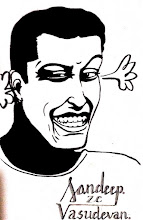On the second day of the first Test between India and West Indies, the evening session was a battle of attrition, India were 50 and a bit and looking shaky. Virat Kohli and Rahul Dravid needed to capitalise on a 73 run lead the gormless West Indian batsmen had handed over, but ran into Fidel Edwards trying to justify his salary. And so Edwards directed bouncer after 90-mile bouncer at Kohli, who fended them off doing his famous impression of an epileptic string puppet. Ah. And then turned around to the glaring cherry bomber and blew him a kiss. A bleeding kiss! Edwards, mortified, blinked a couple of times, looked to his teammates for inspiration, found none and trudged back to his mark to go again.
I remember that because today I watched the famous Fire in Babylon, the movie that the West Indian cricket team was shown before they went out to play at the Kingston test. It was supposed to fire them up with a sense of history and purpose and give them a reason to play cricket again.
And truly, when I watched it, I wanted to be there again, dancing to that rhythm, seeing 11 of the most hallowed cricketing talents ever to be produced strutting their hurt and pain and humiliation and subjugation and indignation on the cricket fields of the world, wrenching for themselves respect and dignity. It was like watching the Berlin wall come down, only much cooler. On account of it has black people in it. Black West Indian people. Nobody’s cooler than that.
It tells the story of how Clive Lloyd took a team suffering from physical battery and professional humiliation, went into the demented little laboratory inside his enormous head and came of out with what was essentially Death in Cricket Whites. It then charts the history of (unarguably) the greatest team in history. After getting creamed by the Aussies 5-1 in the 75 series, and being on the wrong end of the Lillee-Thommo Cricketball Massacre, Lloyd decided to join’em. He got together the most potent pace attack of the time – Roberts, Holding, Garner, Daniels, Croft – and pointed them at the world. The world blinked.
The first victims were the Indians. All square after the first three Tests, the Indians arrived at Sabina Park bouncing with intent and ran into the pace attack. It was painful to watch. Hell, it was painful to read about. And then the West Indians ran amok, doing what they willed for nigh on 20 years, pounding teams into the ground, winning practically everything – and doing it with a swagger and a glare.
Apart from the obvious cricketing talents, what stands out most in the words, voices and eyes of the players who made up that team was the sense of pride, of the realisation of their place not just in sporting culture, but in the struggle for dignity of black people across the world. The film ties up the rise of the West Indies to the rise of the Black Power movement, embodied by Smith and Carlos’ Black Power Salute in the 68 Olympics, Martin Luther King in the US, Mandela in South Africa and the rest of it. These people had taken cricket grounds as the battlefields for emancipation, and they were a beacon to the people of the Caribbean who had suffered the indignity of Babylon for too long.
It’s a brilliant movie, and for true fans of cricket, or even those who just watch Twatty 20, it’s a history lesson and inspiration all at once; it was like the “I have a dream speech” on steroids. But I thought showing it to the current West Indian team was rather counter productive: nothing would have demoralized those guys than to see a team that they can never be. The sense of inferiority and insufficiency that Darren Sammy and his men must have suffered must have been immense. No wonder they folded up. Pride and nostalgia is one thing, but that team was Poetic Justice with a leather ball. This is not.
PS: All Indians used to be happy about Sunil Gavaskar’s 13 centuries and 65 average against the West Indies; here was a little brown man staring down the famed pace attack. Nothing could be farther from the truth. Myth busted here.
Subscribe to:
Post Comments (Atom)

No comments:
Post a Comment